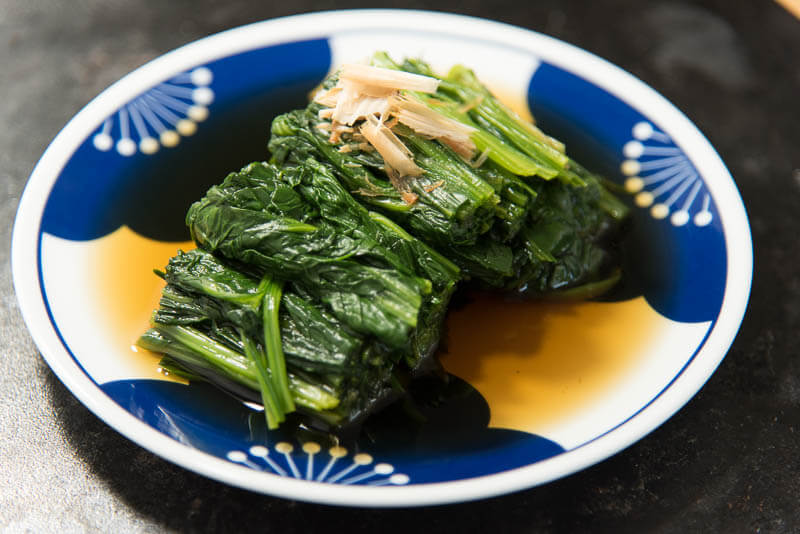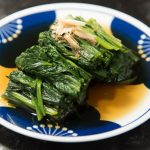I remember growing up watching Popeye eat cans of spinach and instantly growing big muscles. That still didn’t get me to want to eat spinach. I guess back then I was a little stubborn. I don’t know when, but as I grew older I eventually began to like spinach. Aside from just sauteing it with some garlic, olive oil, and soy sauce or making a goma-ae out of it, this spinach ohitashi is one of my favorite ways to eat spinach! This side dish is very light and can be served warm or cold. It’s a great way to add more greens to your diet!

Spinach Ohitashi (ほうれん草お浸し)
Ohitashi is one of the healthiest ways you can prepare vegetables.
It requires no oil and enables you to fully enjoy the natural flavor of the vegetable you’re using.
Today that’s spinach!
But if you’re not a die-hard fan, don’t worry, it’s not gonna be that spinach-y!
The basis of ohitashi includes dashi and soy sauce +/- other ingredients like katsuobushi flakes, water, salt, mirin etc.
The base ohitashi broth you’ll be making will consist of dashi, soy sauce, and mirin.
I like to add mirin because it adds a few layers of complexity.
Some notes on Mirin (味醂):
If possible you always want to try and buy hon-mirin ー本みりん, not aji-mirin-あじみりん.
The difference is that hon-mirin is ‘real’; hon 本 in Japanese means true.
Hon-mirin is made by fermenting steamed glutinous rice, koji (rice with koji mold), and alcohol for several months. It’s then pressed and filtered and is what you get in a hon-mirin bottle.
On the other hand, aji-mirin is made with glucose syrup, water, alcohol, rice and salt.
If you can’t find hon-mirin, it’s not a big deal.
I’ve used both interchangeably and I think the difference would likely be subtle if you were to do a blind taste test.
I just like to keep things as pure or natural as possible. That’s all.

What can you make ohitashi with?
Ohitashi can be made with all kinds of vegetables.
You can use almost any vegetable ranging from broccoli, to tomatoes, eggplant, bell pepper, komatsuna, takenonko (bamboo shoot), mizuna, warabi (bracken leaf) and more!
Aside from changing the vegetable in season you can also vary the soaking broth.
The base is always dashi and soy sauce.
And the dashi we used today was made with konbu and katsuobushi.
But, if you didn’t know, there are many different kinds of dashi.
Each with their own flavor profiles.
This is where things get exciting!
With all the different types of dashi, you can always keep this dish fresh and new.
And to add even more fun to the mix, you can also experiment with different types of soy sauce.
There are hundreds, if not thousands of (artisinal) soy sauce producers in Japan.
Hence, why I bought a mini collection on my last trip over there!

(yes I know bottom left is ponzu 😮 – that ones from Aomori and was made with apple vinegar!)
I’ve noticed there’s even artisanal soy sauce on Amazon now, and some more at my local market.
But it’s pretty awesome that these ingredients seem to get easier and easier to find in the US! That means more selection and flavors for you to try too!
I doubt I’ll be able to try them all, but it’s a lot of fun tasting what I can!
Why should you make this ohitashi?
If you’re not convinced yet, here’s my last attempt.
It’s easy first of all.
It’s healthy second of all.
It’s quite tasty third!
Fourth, you can eat it warm or cold.
Fifth, because it has mild and delicate flavors, it pretty much goes with anything could possibly eat!
But I think it’d go best with a Japanese themed meal (see below) 😉
The only downside to making this is that you need to wait.
I’d advise at least a couple of hours for the flavors to soak in to whatever vegetables you’re using.
Patience my friend.
But if you plan ahead, you can easily double or triple the recipe so you have some ohitashi for a few days on end.
Which for me, is enough consecutive days to get tired of and not want to eat it anymore!
Does that sound like you? 🙂
Until maybe a few weeks later, then I might want to give it another go!
Here’s a quick video Japanese Side Dish | Spinach Ohitashi (dashi based broth) 2018🍱
Tips for making spinach ohitashi-
- To get a neat little stack of spinach like the one above, use a rubber band or food safe string to tie the spinach bunch, then cut into 2 in. sections
- Make sure to squeeze out excess water after blanching or you’ll end up with a dilute and weak flavor
- Cool your vegetables rapidly with ice to stop cooking, for greens like broccoli this will help to preserve their natural vibrant green color
- Add a dash of salt for additional flavor to your blanching water
- Maybe if you like more delicate dashi flavor, or want more of the vegetable flavor, you can cut back on the soy sauce, or vice versa.
- Double or triple the recipe as it tastes just as good the next day!
- If you need dashi, here’s a link to the dashi packs that I use
Not sure what to serve it with?
How about this simple meal?! 😛-
Question of the day: Have you made anything with dashi broth yet? If so, what’s your favorite or what do you plan to make with it? Let me know with a comment below!
See you live later this Wednesday on Youtube @ 6pm PST!

Japanese spinach side dish ohitashi
I remember growing up watching Popeye eat cans of spinach and instantly growing big muscles. That still didn’t get me to want to eat spinach. I guess back then I was a little stubborn. I don’t know when, but as I grew older I eventually began to like spinach. Aside from just sauteing it with some garlic, olive oil, and soy sauce or making a goma-ae out of it, this spinach ohitashi is one of my favorite ways to eat spinach! This side dish is very light and can be served warm or cold. It’s a great way to add more greens to your diet!
- Prep Time: 5 minutes
- Cook Time: 1 minute
- Total Time: 2 hours 6 minutes
- Yield: 2 people 1x
- Category: side
- Cuisine: Japanese
Ingredients
- 1 bunch spinach (washed and tied together with a rubber band)
- 200 ml dashi stock
- 1 ½ Tbsp mirin
- 1½ Tbsp soy sauce
- katsuobushi to garnish
Instructions
- Prepare a large pot of boiling water with a dash of salt.
- Wash and tie together a bunch of spinach with a rubber band.
- Blanch spinach for 1 minute, then drain.
- Use ice to help cool the spinach quickly and stop cooking.
- Cut the spinach into 2 inch pieces and remove the rubber band. Take each 2 inch section and squeeze out excess water.
- Next prepare the sauce, by combining dashi, mirin and soy sauce.
- Put the cut spinach neatly into a container and cover with the sauce. Allow to soak at least 1-2 hours in the refrigerator or room temp.
- After soaking, remove from the container and stack sections on top of each other in a rectangle or like a triangle.
- Pour sauce over and top with katsuobushi flakes before serving!








Konnichiwa! (Hello!) I'm Pat Tokuyama, a Japanese tofu cookbook author, who travels for music, food, and adventure. If you like Japanese tea, checkout some of the newestorganic japanese tea, matcha bowls and noren and more!
** Curious about the Plant Based Japanese Cooking Club? ** Learn more here!